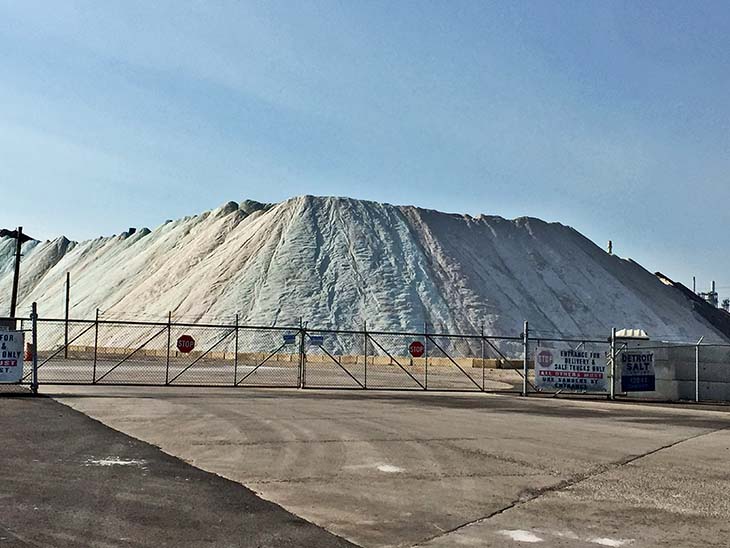

There is no other web page on this site with a picture like what you see: large piles of recently mined salt that will eventually be used to make roads and driveways ice-free on snowy winter days.
About 400 million years ago, much of what is now Michigan was covered by a salty lake. It was separated from the oceans by coral. About 335 million years ago, a continent, named Pangaea, was formed. This one large continent included all the land that then existed on earth. About 175 million years ago, the tectonic plates began to shift and, eventually, the continents we know today broke off from Pangaea. The waters over Michigan were eventually covered by land mass and as they dried, they left a thick bed of salt under southwest Detroit.
When Europeans came to present-day Detroit, they found that Native Americans were using springs in this area as a source for salt. This gave them a clue as to what was under the earth. By 1895, geologists determined that there was, indeed, a layer of salt beneath southwest Detroit, Allen Park and Dearborn. I presume they did some type of test drilling, but I do not know. As the nation industrialized, more and more chemicals and products needed salt.
In 1906, the Detroit Salt and Manufacturing firm was organized with the intention of profitably selling this rich lode of salt. They faced a challenge: the salt bed was 1,060 feet beneath the surface. They began drilling a shaft but went into bankruptcy before they got to the salt. In 1910, a reorganized Detroit Salt Company raised the capital to complete the shaft and started mining the salt.
Two years later, another company, Watkins Salt, purchased Detroit Salt and called the new firm Detroit Rock Salt. They sank the shaft one hundred feet deeper so that they could mine at two different levels. By 1914, they were producing 8,000 tons every month, salt used in the food processing industry and for tanning leather. Business was so good that the firm began drilling a second shaft in 1922, one that was completed in 1925. The mine included more than 100 miles of underground roads spread across about 1,500 acres.
Apparently by the early 1980s, salt from this mine was not price competitive so mining stopped in 1983. The mine was purchased by Crystal Mines, perhaps with the intent of using the vast open underground space as a storage area. I suspect you have heard the discussion that followed how the federal government ran into extremely strong opposition to their plan to store nuclear waste in the Yucca Flats region of Nevada. Some critics of that plan pointed out that the empty salt mine in Detroit would be an ideal storage space for the detritus from nuclear power plants. I do not know if that would be true.
In 1997, a reconstituted Detroit Salt Company purchased the mine from Crystal Salt, and the next year, resumed the mining of salt. The Kissner Group purchased the mine in 2012 but continued to use the Detroit Salt Company name. At present, all the salt brought to the surface here is used for ice removal from roads, driveways and walks.
For many years, tours were regularly given of the mines. That ceased, I believe quite some time before the mines went into their 15-year hiatus in 1983.
I suspect that Detroit is the only one of the nation’s largest cities that includes a major mining firm operating within the city.
Use in 2017: Salt mine
City of Detroit Designated Historic District: Not listed
State of Michigan Registry of Historic Sites: Not listed
National Registry of Historic Sites: Not listed
Photograph: Ren Farley, July, 2018
Description prepared: November, 2018
Return to Industries
Return to Homepage